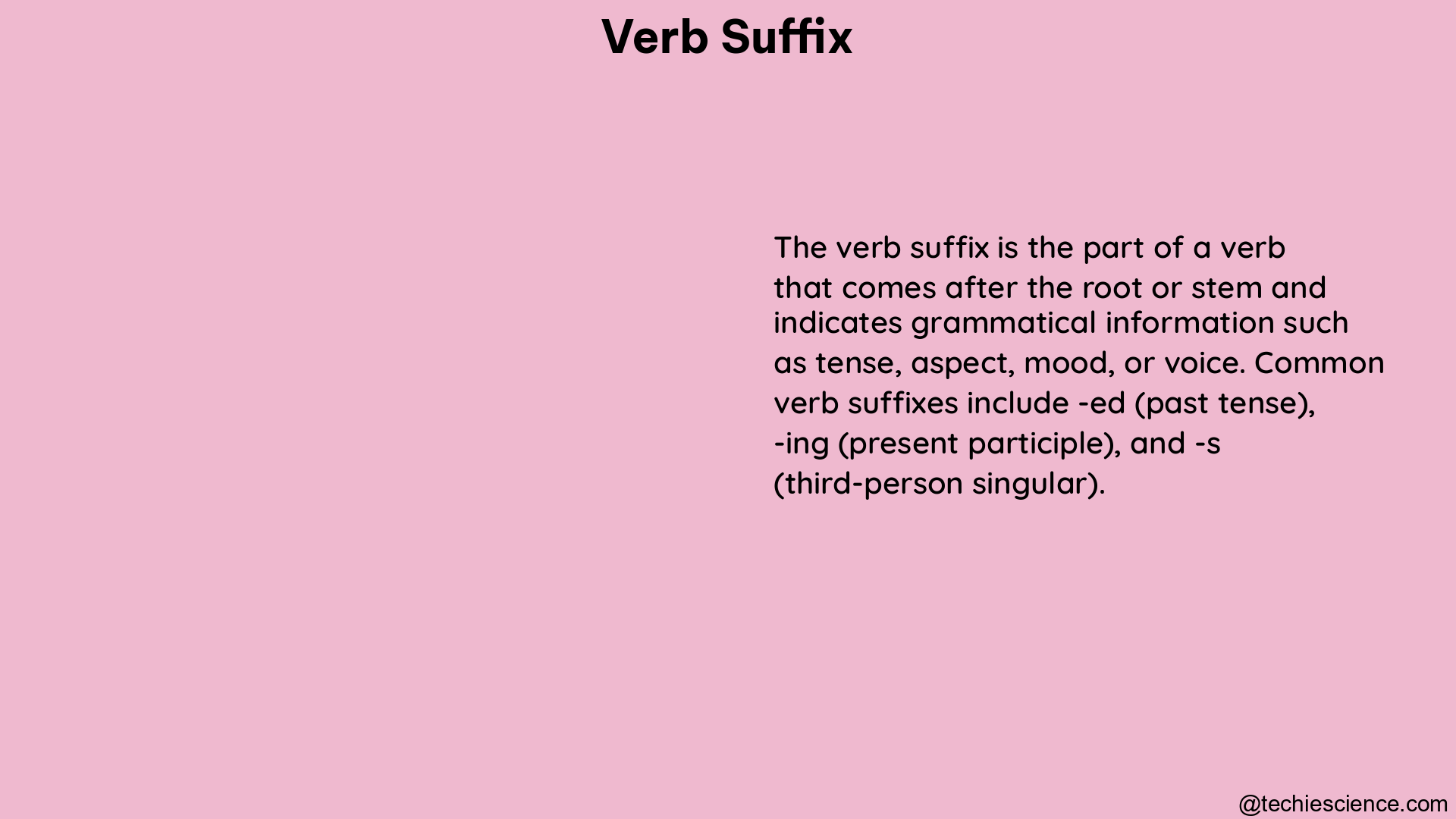Verb suffixes are a crucial aspect of the English language, as they play a vital role in extending vocabulary and understanding the meanings of unfamiliar words. These small, yet powerful, additions to the end of a base word can transform the meaning and function of a verb, making them an essential tool for effective communication and writing.
Understanding the Purpose of Verb Suffixes
Verb suffixes are letters or groups of letters that are added to the end of a base word to form a new verb. These suffixes often have specific meanings and can help you understand the nuances of a verb’s function or the state it represents. By familiarizing yourself with common verb suffixes and their associated meanings, you can expand your vocabulary, improve your language skills, and gain a deeper understanding of the English language.
Common Verb Suffixes and Their Meanings

1. The “-ate” Suffix
The “-ate” suffix is used to indicate that the verb brings about a particular state or condition. It often denotes the action of causing something to be in a certain state or to become a certain way. Examples of verbs with the “-ate” suffix include:
- Demonstrate: To show or exhibit
- Generate: To produce or create
- Communicate: To exchange information or ideas
- Suffocate: To deprive of air or oxygen
- Illustrate: To provide an example or visual representation
2. The “-en” Suffix
The “-en” suffix is used to indicate that the verb represents a change or transformation into a particular state or condition. It often denotes the action of becoming something or the process of changing. Examples of verbs with the “-en” suffix include:
- Shorten: To become shorter
- Thicken: To become thicker
- Widen: To become wider
- Strengthen: To become stronger
3. The “-ify” Suffix
The “-ify” suffix is used to indicate that the verb represents the action of making something or becoming something. It often denotes the process of transforming or creating a particular state or condition. Examples of verbs with the “-ify” suffix include:
- Clarify: To make something clear or understandable
- Identify: To recognize or establish the identity of something
- Modify: To change or alter something
- Simplify: To make something simpler or easier to understand
4. The “-ise/-ize” Suffix
The “-ise” and “-ize” suffixes are used to indicate that the verb represents the action of doing something or becoming something. They often denote the process of transforming or adopting a particular state or condition. Examples of verbs with the “-ise” and “-ize” suffixes include:
- Criticise: To express disapproval or judgment of something
- Realise: To become aware of or understand something
- Modernise: To make something more contemporary or up-to-date
- Optimise: To make something as effective or efficient as possible
Examples of Using Verb Suffixes
- Communicate: I like to communicate with my team to ensure we are all on the same page.
- Widen: We decided to widen the roads to accommodate the increasing traffic flow.
- Clarify: Can you please clarify what you meant by that statement?
- Realise: I realise the importance of suffixes now that I have learned them.
Key Considerations When Using Verb Suffixes
- Word Class Changes: Adding a suffix to a base word can often change the class of the word, transforming it from one part of speech (e.g., a noun) to another (e.g., a verb).
- Meaning Shifts: While the word class may remain the same, adding a suffix can significantly alter the meaning of the new word, often introducing a new nuance or connotation.
- Spelling Adjustments: The addition of a suffix can sometimes require changes to the spelling of the base word, such as the doubling of consonants or the removal of silent letters.
Mastering Verb Suffixes: Strategies and Exercises
To effectively master the use of verb suffixes, consider the following strategies and exercises:
-
Familiarize Yourself with Common Verb Suffixes: Spend time studying the most common verb suffixes, their meanings, and examples of words that use them. This will help you recognize and understand these suffixes when you encounter them in your reading and writing.
-
Practice Identifying Verb Suffixes: As you read, pay attention to the words you encounter and try to identify the verb suffixes. Analyze how the suffix changes the meaning of the base word.
-
Create Your Own Examples: Experiment with adding different verb suffixes to base words and observe how the meaning of the word changes. This will help you internalize the patterns and applications of these suffixes.
-
Incorporate Verb Suffixes into Your Writing: Consciously use verb suffixes in your own writing, ensuring that you understand the nuances of the words you are using and that they fit the context appropriately.
-
Consult Reference Materials: Utilize dictionaries, grammar guides, and online resources to deepen your understanding of verb suffixes and their usage. These materials can provide additional examples, explanations, and exercises to reinforce your learning.
By mastering the use of verb suffixes, you will not only expand your vocabulary but also develop a more nuanced understanding of the English language. This knowledge will enhance your ability to communicate effectively, express yourself precisely, and engage in more sophisticated and meaningful conversations.
References
- Cambridge Dictionary – Suffixes – English Grammar Today – Cambridge Dictionary
https://dictionary.cambridge.org/us/grammar/british-grammar/suffixes - ABC Education – Commonly used verb suffixes – ABC Education
https://www.abc.net.au/education/learn-english/commonly-used-verb-suffixes/13159112 - Grammarly – What Are Suffixes in English? Definition and Examples – Grammarly
https://www.grammarly.com/blog/suffixes/
Hi… I am Sowndharya Jagadeeswaran, a university rank holder in M.A. English Literature. I have also done my master’s in Business Administration. Inquisitive as I am, my interest in action-oriented research helped me publish research papers in reputed journals. Now, as a career, I am an instructor where I teach young and adorable students the intricate technicalities of Public Speaking and Creative Writing. I also enjoy writing articles on topics I specialize and research in.
You can connect with me through LinkedIn.-